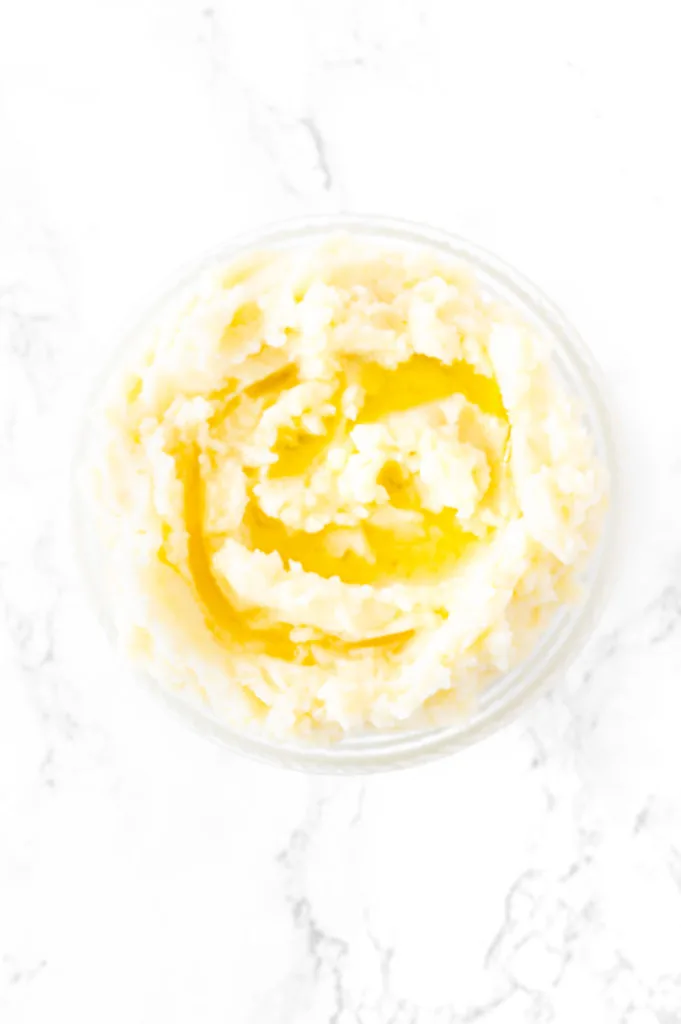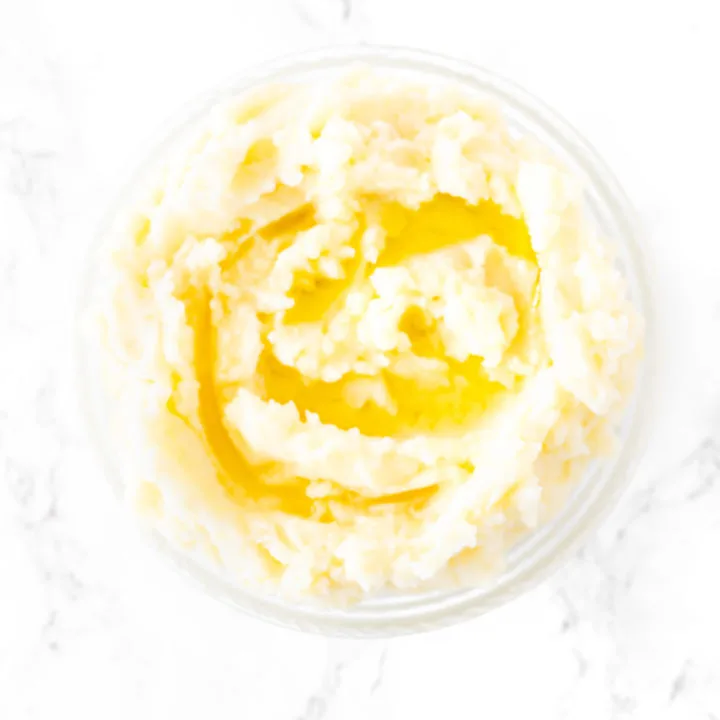These dairy free mashed potatoes are made without butter but are still incredibly creamy and have a delicious flavor! They are a wonderful addition to any dairy free dinner and are perfect for special occasions like Thanksgiving.

Mashed potatoes are a great side dish because they are very healthy, filling, and relatively low in calories. However, when you load them with cheese, butter, cream cheese, and more…. I think they lose some of their appeal.
To me, when you do all of that, you miss out on the delicate flavor mashed potatoes have that allows the rich main dish to shine.
Even early recipes for mashed potatoes didn’t call for all that… though it did call for milk and butter.
The following is an excerpt from The Art of Cookery by Hannah Glasse in 1747, which is the first known recipe for mashed potatoes.
Boil your Potatoes, peel them, and put them into a Sauce-pan, mash them well: To two Pounds of Potatoes put a Pint of Milk, a little Salt, stir them well together, take care they don’t stick to the Bottom, then take a quarter of a Pound of Butter, stir in and serve it up.
These dairy free mashed potatoes are full of flavor but they still let the main dish shine. Since the garlic is boiled, it has a subtle flavor that really enhances the side dish.
About Dairy Free Mashed Potatoes
While mashed potatoes don’t have to contain dairy, they almost always do.
Most mashed potato recipes include milk, buttermilk, cream, butter, sour cream, and/or cheese.
You can make mashed potatoes without milk by replacing it with another liquid, such as almond milk, oat milk, coconut milk, reserved starchy water, regular water, chicken stock, or vegetable stock.
It doesn’t really make a difference if you use milk, water, or any other liquid because one isn’t necessarily better than the other.
To replace buttermilk in mashed potatoes, substitute it with dairy free buttermilk by using buttermilk made with oat milk or buttermilk made with almond milk.
To make mashed potatoes without butter, you need to substitute the fat in butter with another form of fat, like oil.
Mayonnaise is also a surprisingly good substitute for butter and sour cream in mashed potatoes.
How to make creamy mashed potatoes without milk?
Additions like dairy free milk, coconut cream, almond cooking milk, water, and mayonnaise can all help make something creamy without dairy.
What you use really depends on what you are making. With dairy free mashed potatoes, any of these options work.
Milk actually doesn’t make mashed potatoes super creamy. It mostly just adds liquid so the potatoes aren’t dry.
It is the addition of fat that makes mashed potatoes and other dishes creamy.
This fat usually appears in the form of butter or sometimes cream cheese or even sour cream.
However, you can use other forms of fat, such as oil, to get that creaminess.
To make them extra creamy, add a little bit of mayonnaise like I do in this recipe. You won’t taste the mayonnaise but the mashed potatoes will be oh so creamy!
How can I thicken potatoes without milk?
My favorite way to thicken mashed potatoes without milk is just a little bit of mayonnaise, like I do in this recipe.
How do you make mashed potatoes without milk or butter?
Mashed potatoes can be made easily without butter or milk.
What you need is a liquid – whichever you prefer – so the potatoes aren’t dry.
Then, you need a fat to help make them creamy. Butter is usually used, but fats like olive oil, animal fats, and even mayonnaise can be used.
My personal favorite is mayonnaise, which is a surprisingly versatile ingredient.
Can I use almond milk in mashed potatoes?
Yes, almond milk can be used in mashed potatoes. Unsweetened barista styled almond milk is best because it is most similar to milk.
DO YOU PEAL POTATOES BEFORE BOILING FOR MASHED POTATOES?
You can, but you don’t have to. Potatoes that have clean skin can be washed and left on.
I like leaving the skins on, but I choose which way to do it based on the preferences of whoever else will be eating it.
TYPES OF POTATOES
There are generally three types of potatoes: waxy, starchy, and those in between.
WAXY
Waxy potatoes, such as Red Bliss and fingerlings, have a smooth skin and creamy, almost shiny flesh.
Because waxy potatoes are relatively low in starch and high in moisture, they stay intact when they’re cooked.
STARCHY AKA FLOURY
The most common example of starchy potatoes are russets, A.K.A. Idaho potatoes.
As you may have guessed by their name, they’re higher in starch and lower in moisture than waxy potatoes. They are matte-skinned and fall apart when boiled.
Starchy potatoes are ideal for adding creaminess to puréed soups or providing the airy, whipped texture to a mash. They are also good for roasting and frying.
IN-BETWEEN
These fall somewhere between the waxy and floury, making them the “all-purpose” potatoes. The most commonly known of them are Yukon Golds.
Because they hold their shape when boiled, grated, or fried and yield to mashing, they’re very versatile.
BEST FOR MASHED POTATOES
Since the waxy are most flavorful but the starchy are airiest, for the ideal mashed potatoes, use half and half. This is a tip I picked up from the New York Times.
However, if you could only choose one, choose the in between option like Yukon Gold.
Or, if where you live you don’t have any clear way to know what type of potato you have available, use whatever you have.
WATER TEMPERATURE
Believe it or not, it’s best to begin cooking potatoes in cold water. It doesn’t have to be chilled, just the cold side from the tap.
While this may sound counterintuitive, cold water helps the potatoes cook more evenly.
Also, if it’s better that way, why waste the gas and cooking time by boiling the water?
SECRETE INGREDIENT
My secret ingredient to perfectly creamy mashed potatoes is… mayonnaise!
Shocking, right?
Mayonnaise is actually great in cakes, quick breads, and when used for grilling, frying, and roasting.
I use a little bit of it in here because I like letting the potatoes speak for themselves. However, you can use up to half a cup if you want a more pronounced flavor.
So, why mayonnaise? Because it makes your mashed potatoes creamy, and as a bonus, it doesn’t harden up in the refrigerator, so you can make them ahead of time.
Even if you don’t like mayonnaise, don’t worry, you don’t taste it at all when it’s just two tablespoons for 2 pounds of potatoes.
MAKE AHEAD OF TIME
Unlike typical mashed potatoes, these mashed potatoes can be made ahead of time. Usually, mashed potatoes get hard in the fridge due to all the butter, but the mayonnaise keeps these just as creamy.
Simply make the day before (or even a few days before) and reheat when ready to serve.
HOW TO STORE
Place in an airtight container or leave in a bowl and wrap in plastic wrap and refrigerate. Yield: Serves 4 to 6.
Mashed Potatoes Without Butter

These dairy free mashed potatoes are made without butter, but are still incredibly creamy and have a delicious flavor!
Ingredients
- 2 pounds potatoes, pealed and cut into 1-inch chunks
- 8 cloves garlic
- 1/2 cup vegetable or chicken stock
- 2 tablespoons mayonnaise
- Salt
Instructions
- Place potatoes and garlic in a large sauce pan. Cover with water.
- Bring to a boil, lower to a simmer, and cook until tender - about 15 minutes.
- Drain water but reserve 1/2 cup of liquid. Add mayonnaise and mash the potatoes and garlic.
- Slowly mix in stock until you reach desired consistency. If you run out of stock and still have not reached your desired consistency, slowly mix in the remaining water. Salt to taste.
Nutrition Information:
Yield:
6Serving Size:
1Amount Per Serving: Calories: 202Total Fat: 4gSaturated Fat: 1gTrans Fat: 0gUnsaturated Fat: 3gCholesterol: 3mgSodium: 107mgCarbohydrates: 37gFiber: 4gSugar: 3gProtein: 6g